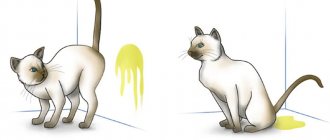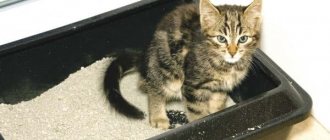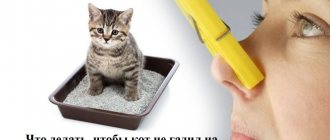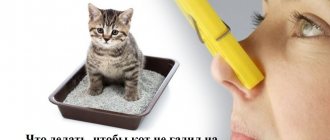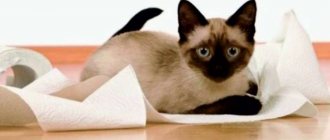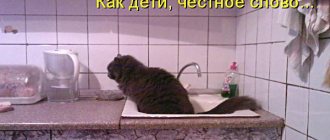Let's say you have a furry pet living in your house and suddenly one or more flowers begin to turn yellow or die for no reason. Most likely, this cat got into the habit of relieving itself in a flower pot. How to stop a cat from pooping in flower pots?
Obeying instinct, cats bury their feces in the ground. Perhaps this happened in your case too. If the suspicions are confirmed, you will have to try to wean your pet from this activity.
Why do cats dig in flowers?
There are several reasons why domestic cats climb on pots of soil and chew green spaces in the house. Here's what experts think about this:
- Lack of vitamins and microelements in the animal’s body. Street cats look for medicinal grass and eat it, which allows the body to obtain the necessary substances. Domestic cats can eat plants in flower pots, which is very unsafe for the animal itself. For example, some types of house plants are poisonous, and if a cat begins to gnaw on such a stem, there is a high risk of severe poisoning of the animal.
- The cat is looking for a convenient place to go to the toilet. For example, the animal does not like the filler in the tray, but the soil in flower pots is very convenient for this matter. The reason for this cat behavior can also be an uncleaned litter box. Keep the cat litter clean and change the litter in it in a timely manner.
- Cats can climb on window sills and damage green spaces solely because of resentment toward their owner due to lack of attention. With this behavior, the cat not only wants to take revenge, but also to draw attention to itself.
It is not difficult to understand the main reason why a cat climbs into flower pots. If an animal digs the ground and relieves itself there, it means that she is unhappy with her cat litter. The cat eats the stems and leaves of plants - its body lacks vitamins. An animal simply spoils flowers in pots, throws them on the floor, chews leaves or breaks branches - a clear sign of a lack of attention on your part.
How to remove odor from a mattress and furniture
Urine, absorbed deep into the “depths” of upholstered furniture, is no longer accessible to surface treatment
If the urine is deeply absorbed, it is useless to spray odor eliminators on top; you will have to act radically: rip out the upholstery or remove the cover from the mattress, take out the foam rubber, wash the fabric, and put in a new filler.
If there is a risk that the cat will shit on the bed again, you should cover the mattress with oilcloth.
Methods to combat the problem
The first thing to do in this situation is to raise the cat and, whenever you try to get close to the flower pots, say loudly “No!”
Observing your pet will give you an answer as to why he does this.
Observe, maybe the cat climbs onto the windowsill not in order to spoil your green spaces in the house, but in order to get closer to the window and inspect everything that is happening on the street. In such a situation, the problem can be solved easily and simply! Remove a couple of peas from the windowsill to create an observation deck for your inquisitive kitty.
If your cat digs the ground and shits in it, try changing the type of litter for the litter box. Did not help? Then use a special spray to repel animals. You can buy it at a pet store.
Traditional methods also work effectively:
- Place citrus peels near the plants, pets cannot tolerate this smell;
- cats also don’t like the smell of garlic, place garlic cloves next to flower pots;
- Cover the window sill with food foil, animals do not like to walk on a rustling surface;
- you can use a spray bottle of water to scare away the cat; water treatments will quickly eliminate interest in walking on window sills;
- flower pots can be lubricated on the outside with “Star” balm or essential oils with strong odors;
- Some are helped by ordinary toothpicks, tightly inserted into the ground with flowers with the sharp side like a “hedgehog”; a couple of unpleasant touches will reduce the cat’s interest in home flowers;
- cover the soil in the pots with small pebbles, they will not harm the plants, but will eliminate the cat’s interest in the filler of the flower pots;
- You can put double-sided tape next to the pots; cats don’t particularly like to walk on sticky surfaces.
If your furry friend eats plant leaves and stems, try planting a pet-specific grass in a pot. You can buy such seedlings at a pet store. Green grass is rich in various vitamins and microelements, which will bring undeniable benefits to the body of your tailed pet.
Repellent orange peels
The smell of citrus fruits is one of the least favorite for the cat family. I have long noticed that our favorite avoids the New Year's table. But the point turns out to be this: an abundance of oranges and tangerines. How can they help protect flowers from being eaten? Very simple. You need to spread orange (tangerine) peels around indoor flowers. If citrus fruits are not in season, a colleague advised using vinegar. You need to saturate the cotton wool with it and put it in the pot. True, this smell also scares me away. But in order to save your favorite flower, you can endure a little. Over time, the vinegar disappears, and the cat is re-educated.
We recommend: How to properly care for sanchetia for interior landscaping
Consequences of eating houseplants
As we have already said, many plants in the house are poisonous species, and after consuming them, the animal may be in real danger. What may be the consequences of consuming poisonous plants:
- prolonged diarrhea in a cat;
- nausea, vomiting, loss of appetite;
- severe dehydration of the body;
- general weakness, coma;
- death.
If you do not want to lose your furry friend, protect him from the following plants in the house: dieffenbachia, caladium, azalea, philodendron, schefflera, chrysanthemum, ivy, cyclamen, etc. If your cat has managed to eat the leaves or stems of poisonous plants, immediately take her to an experienced veterinarian.
Cats look for healing herbs and eat it, help them find it
To bring your animal to the doctor, provide him with first aid to neutralize the effects of dangerous poisons:
- do a cleansing enema with warm water;
- Give your cat a mixture of vegetable oil, egg whites and milk.
Never leave your cat alone with dangerous plants in the house. Better yet, get rid of such plantings if a furry pet has settled in your home.
Be sure to raise your cat from the first days of being in your family. Love, but do not pamper, mark the boundaries of what is permitted. If the animal behaves badly, scold it, but for good behavior you can reward it with your favorite treat.
You need to raise an animal correctly, without involving physical violence in this matter. Only instructive conversations in a strict intonation will allow you to raise an obedient cat with good manners and decent behavior.
Well, many owners are simply lucky with indoor cats who do not show any particular interest in indoor plants. If your pet is more inquisitive and has already managed to get into trouble on the windowsill, use the above methods to deal with the bad behavior of your four-legged friend.
Saving the carpet
The cat took revenge on one of the household members and made a puddle on his beloved and beautiful carpet. How to remove and how to get rid of this terrible smell? Let's try to save your carpet using the following methods:
- Laundry soap with glycerin. Thoroughly soap the stained area on the carpet, let it dry and rinse the carpet with clean water.
- Hydrogen peroxide, liquid soap and water. Pour into a spray bottle, apply to a dirty stain (pre-treated with soda), foam with a sponge, dry and vacuum away any remaining product.
- Glycerin is excellent at breaking down stone and is often used for both carpets and other surfaces.
- Soda with vinegar. Remove the fresh puddle, wipe dry and pour 3% (not 10%) vinegar over the contaminated area, let it dry, then sprinkle thoroughly with baking soda. Leave the product overnight and vacuum.
Why do they do this
Animals of any gender and age can shit in the wrong place. Experts say that most often an unpleasant situation arises not because of the cat’s poor upbringing or character, but because of health problems or as a way of realizing instincts and natural needs. Pets go out of place because:
- They are not satisfied with the location of the tray in the apartment. You need a fairly secluded place away from prying eyes. If something constantly distracts and bothers your cat while visiting the toilet, he can choose another corner or the owner’s sofa for this.
- The tray is too small or has a strong smell of detergent. The cat is uncomfortable in such a toilet and, not wanting to experience discomfort, she looks for another place.
- It is possible that the animal does not like the look of the filler. The range of these products is now wide, try changing the filler to some other one, this may solve the problem.
- Tray not removed on time. Cats are big cleaners and if their litter box is filled with excrement, they may refuse to use it. If you are away from home for a long time, it is better to put another tray so that the degree of contamination of the cat litter is not excessive.
- The cat has changed its place of residence or has experienced stress. In the first case, the animal may simply not yet get used to the new place, and in the second, it expresses its feelings in this way.
- Infection with worms, intestinal and genitourinary diseases can cause pain in a cat when defecating. In this case, the pet will associate the litter box with causing pain and he will avoid going to the toilet. In this case, only a visit to the veterinarian and further therapy will help.
- After all, cats may simply be marking their territory. They will visit the litter box, but at the same time they leave marks and odorous puddles throughout the apartment. The situation will be corrected by castration or free walking, during which the pet will find a sexual partner.
The kitten shits everywhere except the litter box
A kitten is a special case. When a kitten shits in the wrong place, this is a slightly different situation. Usually, babies are taught to use the litter box and many other things by their mother. But a cat is not always a good mother. Young, inexperienced cats can teach their kittens little, and sometimes even refuse to feed them breast milk.
Kittens quickly master the science of behavior in an apartment
If the cat has not done this, the breeder must accustom the kitten to the litter box. Babies grasp everything on the fly, and if they are regularly placed in a tray after eating and sleeping, the kittens quickly master this science and no longer shit anywhere. But sometimes the kitten is taken to another house when it is very young, or your apartment has too many rooms in which it is easy to get lost.
Having brought your baby to you, stay at home with him for the first few days. It is better to limit access to most rooms and put the kitten in the toilet as soon as he squeaks, shows anxiety, and immediately after he has eaten and slept. Two to three days will be enough for the cat to learn where he needs to relieve his needs.
Only if these rules are not followed can it happen that the baby will shit anywhere. After all, if you do not persistently show him where the toilet is, he will choose this place for himself, and maybe more than one.
How to stop a cat from crapping in the apartment yourself
Use the following simple tips to correct the situation when your cat shits:
- Experienced owners who have raised more than one cat claim that it will never defecate where it eats food. If you find a place where a cat or kitten regularly poops, place a bowl of food there, or scatter food nearby on a piece of paper.
- Some people suggest scaring the animal. As soon as you catch your cat doing something bad, spray him with water from your hand or from a spray bottle. The fear he has experienced will discourage him from crap in this place. You can also knock loudly nearby with a rolled-up newspaper.
- Give the animal more attention. Perhaps the cat is simply bored without you or is experiencing stress from the appearance of a small child or another animal in the house. Your task is to create a feeling of comfort and safety for him, then the cat will not urinate on your carpet and on your things.
It is useless to poke the animal’s nose into its piles or puddles; this will not help wean the cat from a bad habit. Cats do not tolerate violence and instead of the desired effect, you risk getting the opposite result. Your pet may forever lose trust in you and become angry, but he is unlikely to understand his guilt.
What to do with fresh puddles on the floor and carpets
Step 1.
As soon as the house smells of cat urine, you need to put aside all your business and find the “crime scene” as quickly as possible.
It is important to detect a wet spot on the rug as quickly as possible
Regardless of where your cat peed, the first step is to remove as much fluid as possible. The puddle needs to be thoroughly blotted with paper towels, toilet paper, and old dry rags that you don’t mind throwing away. The less urine left, the better.
It is advisable to blot the moisture as best as possible. Use gloves
It is advisable to put the used paper/rag in a bag and immediately take it to the trash can, otherwise the bin will also stink.
It is also advisable to immediately open the window and thoroughly ventilate the room.
Important! At the same time, searching for the cat throughout the house, shouting at it, or poking its nose into a puddle is categorically not recommended. It’s especially not worth beating an animal for an offense.
Step 2.
To remove residual moisture, you can cover the stain with a layer of baking soda or certified salt. Powders will absorb urine as an absorbent, making it much easier to get rid of the smell. Baking soda and salt can be mixed with washing powder in equal proportions to achieve a better effect.
Baking soda and salt will absorb remaining moisture
Step 3.
After half an hour, the powder can be removed with a rag or vacuum cleaner (if the dust collector is not a fabric bag, but a plastic container).
The main part can be collected with a rag or sponge
Step 4.
The final stage is surface treatment to eliminate residual odor and yellow stains. For this purpose, specially designed liquids are used (sprays, carpet shampoos, etc.), as well as products and medicines available in the house.
Carpet cleaning products
Important! The worst product for removing the smell of cat urine is “Belizna” and all chlorine-based household chemicals. The smell of urine will only intensify after treatment. The exception is a concrete floor - it can be washed and disinfected with bleach.
“Whiteness” is only suitable for washing floors; it is better not to wash carpets and rugs with chlorine-containing products
You shouldn't spray a wet spot with perfume either. Firstly, it will not help hide the pungent, persistent unpleasant odor. Secondly, the combination of the scent of urine and the scent of perfume is not the best.
Video - How to remove the smell from cat urine? Lifehack
Aids
Sometimes it is worth using additional means to solve the problem of getting rid of unauthorized puddles.
- An animal experiencing stress can be given calming drops based on natural ingredients, purchased from a veterinary pharmacy.
- If the animal is overly excited by unrealized sexual instinct, and you cannot use castration for some reason, purchase special contraceptives for cats, for example, Gestrenol. Just keep in mind that long-term use of such drugs is not advisable - this can cause disruptions in the hormonal system. Over time, it is still better to neuter your pet.
- On sale you can find special repellents in the form of a spray (Gimpet, Himola Antigadin). They are used to treat the places where the cat has soiled itself and, according to the manufacturers, this will discourage the cat from shitting there again.
- A simple, cheap remedy – table vinegar – will also help. It is necessary to first clean the floor in the place where the cat pooped, and then wipe it with a piece of cloth soaked in vinegar, or spray the product from a spray bottle. The cat will avoid such a strong smell.
- Some people use bleach or ammonia to repel the smell, but be careful, not all surfaces can be treated with them. So, dark linoleum or parquet can easily be ruined by bleach, which eats away the paint. For upholstered furniture, for the same reason, it is better to use specially designed commercial sprays that will not harm it.
If a cat shits in a flower pot, it is better to put the pots that the cat likes in an inaccessible place: on a shelf or glass balcony, or a special flower stand. You can organize protection directly in the pot by placing chopped lemon or garlic slices on the surface of the soil.
As an option, you can purchase a mineral filler for the tray, this will allow the animal to squirm around there to its heart’s content and realize its instincts. As you can see, there are quite a few ways. Try the ones that seem most suitable to you. Something will definitely help stop your cat from shitting anywhere.
Folk recipes
- White vinegar is a remedy that can eliminate even old odors. To prepare the solution, mix water and vinegar in a 1:1 ratio. Then you should wipe the urine with a regular rag and only then rub the prepared solution into the stain. Vinegar completely neutralizes the ammonia smell coming from urine. After some time, do not forget to wipe the treated area dry.
- Cleaner (enzymatic) . You should wash the urine dry and treat the area with a ready-made product. It contains special biological enzymes that quickly break down proteins in urine, thereby instantly eliminating unpleasant odor. An enzymatic cleaner can always be purchased at a specialty store. The product is great for removing odors from upholstered furniture and bed linen.
- Apple cider vinegar should be mixed equally with regular laundry detergent, applied to the dirty area, rubbed in thoroughly and left to act for several minutes. After this, remove the product with a regular rag.
- Bleach (no ammonia) . Wash the contaminated area with a regular cleaning agent and remove with clean water, wipe dry and treat with the prepared composition: mix water and bleach (1:10), pour into a spray bottle. Use the product very carefully, since the chlorine contained in it can ruin the color and surface structure.
- Iodine . Prepare a solution: stir 10 drops of iodine in 1 liter. water, then use it to treat the contaminated surface, leave for 10 minutes and wipe dry.
- Soda . Sprinkle the surface with regular baking soda. This natural product perfectly absorbs any odors. If the contaminated area is small, just rub soda into it with a sponge and leave for several hours, vacuum and wash with water.
- Squeeze the juice from the lemon, apply it to a cloth and gently clean the dirty area.
- Mix dishwashing liquid (2 tsp) with 0.5 tbsp. hydrogen peroxide. Apply it to the contaminated area (previously sprinkled with soda). Rub the solution thoroughly until foam is obtained, then allow to dry, vacuum and remove any remaining product with clean water.
- Mouthwash . First, remove the urine and wipe the surface dry, apply rinse aid to the stain, let it dry, repeat the procedure.
- Potassium permanganate is a strong oxidizing agent and an excellent deodorizing agent. Prepare a weak solution and treat the contaminated area with it, let it dry. Repeat cleaning (washing) several times until the cat smell disappears completely.
Among the most effective folk remedies are sleeping tea and Lenore.




